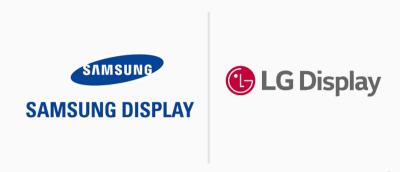In this article, we examine the theoretical question of whether or not it makes sense for Samsung Display to acquire LG Display.
Note that we have no indications that such a merger is even considered by the two companies, but we feel this is a fascinating topic that should be explored, and is supported by several strong arguments.
We'll start with a short introduction to the two companies, then see why there are many reasons to pursue a merger, then explain the reasons against a possible merger, and finally detail the current financial situations of both companies.
Samsung Display and LG Display
Samsung Display Corporation (SDC) is a subsidiary of Samsung Electronics. SDC is a leader in OLED production, with a market share of over 40% in the small OLED display market (the second largest player, BOE, holds a market share of around 15%). SDC produces over 300 million AMOLED displays per year - supplying them to Apple's iPhones and tablets, Samsung Electronics Galaxy phones, and many more. The Company also produces larger-area QD-OLED panels for TVs and gaming monitors, and has a capacity of producing around a million TV panels per year. SDC no longer produces any LCDs. SDC does produce microLED displays (but on a very small scale, this is currently a strictly next-gen display technology), and the company develops OLED microdisplays (and also holds OLED microdisplay producer eMagin which it acquired in 2023 for $243 million).
LG Display (LGD) was established as a JV between LG Electronics and Philips, and was initially known as LG Philips LCD. The Company became independent in 2004 and is now a public company. LGD produces small AMOLED displays, supplying Apple's iPhones and Watch devices and more. LGD is the world's leading producer of large-area OLED TV panels, using its own WRGB/WOLED technology, with a production capacity of almost 10 million TV panels per year, supplying these to LG Electronics, Sony, Panasonic, Samsung and others. LGD is developing OLED microdisplay technologies, and is also starting to produce microLED displays. LGD will sell its last LCD fab in 2025 to TCL CSoT and will become focused entirely on OLED displays (and microLEDs).
Why does it make sense for LGD and Samsung to merge?
We believe that merging LGD and SDC could be very beneficial, for both companies. First all, both SDC and LGD share a main focus: they are almost entirely focused on OLED technologies, and have both sold their LCD businesses. Both companies also agree that the leading next-generation display technology is microLED, and are already invested in advanced R&D in that area.
Interestingly, in many technology areas, SDC and LGD complement each other. Samsung is the leader in small-area rigid and flexible AMOLED production. While LGD is also active and successful in small-area AMOLED production, it is mostly focused on large-area WOLED panel production, and is the clear leader in that area . It is true that Samsung Display is producing QD-OLED large-area panels, but the future of that technology is unclear. A combined SDC+LGD company will be able to lead in all aspects of OLED panel production, from small-area to large-area.
The key reason for SDC and LGD to consider a merger is the competition from China. In recent years, Korea's share in the global display market has continued to erode, as Chinese-based display makers have almost completely taken over the LCD industry, and are also advancing very quickly in the OLED industry. Korea considers its display industry to be a strategic one, but it hasn't been able to effectively maintain its market share, or its massive technology lead.
Samsung and LG are still ahead of their competition in some technologies, and in their production capacity, but it is not clear whether this advantage will be maintained for long. A combined company may find it easier to compete, as it will be able to combine its small-area AMOLED production units, while being able to divert more resources into advanced display R&D.
In addition, the Korean government could support such a move, and provide financial or legislation benefits. If this will be a real merger, the new company may adopt a name such as Korea Display, or something like that, to make sure it has local support. Probably better than name ideas like "Samsung.LG" or "SamG Display" or perhaps "LSung Display".
As will be detailed below, Samsung Display is very profitable, and has very good access to capital. LG Display, on the other hand, finds it challenging to invest in new OLED capacity. In addition to its expertise in large-area OLED production, LGD is also leading in two important AMOLED fields - tandem OLEDs and automotive OLEDs. Tandem OLED technology is becoming extremely important for both the IT market (laptops and tablets), and the automotive market, a key segment for the future. By acquiring LGD, Samsung will gain access to the important tandem OLED technology - and to the automotive market. Of course a merged company could dispose of many duplicate resources and streamline operations, thus increasing profitability.
Up until a few years ago, people would have dismissed the idea of a merger between LG and Samsung, as these two companies were bitter rivals, that even (allegedly) came to actual violence and several legal battles. In 2015, though, the two companies ended their legal dispute, and in 2023 Samsung Electronics started buying WOLED panels from LG. In 2024, the two companies deepened their collaboration further. To ensure the survival of Korea's display industry, the next logical step could be a merger.
Why doesn't it make sense for LGD and Samsung to merge?
To complete the analysis, let's look at reasons why this merger won't (or shouldn't) happen. First of all, there are regulation aspects to be considered, and such a big merger may find regulatory restrictions. Note that the combined company, while becoming a big display leader, won't monopolize the market (and will reach around 50% of the total OLED market, combined).
Second, a merger could hurt some of the business of the two companies. For example, today Apple is a major customer of both companies. Apple prefers to have several suppliers, and if LG and SDC become one, Apple could increase its sourcing from other OLED makers (such as BOE or Tianma), which means that total combined shipments to Apple may fall from current levels.
A danger in any merger is that it is not easy to combine two companies with different cultures, and different technologies. For example, what will be the fate of SDC's QD-OLED technology in a combined company? The internal politics in a merged company may lead it to make bad business and technology decisions.
A look at SDC and LGD financials
To understand what a merger between SDC and LGD may look like, let's consider the financial position of these two companies. We'll start with LGD, where it is easier, as it is a public company. LGD's revenues in 2023 were $15.8 billion, down from around $22 billion in 2021. The company has been experiencing losses in the last two years ($2 billion in 2023, $2.3 billion in 2022). LG Display has been struggling to remain profitable - and in fact most companies in the display industry have been in the same situation as display production requires immense investments, and is mostly a commodity market, and so price competition is fierce.
Samsung Display is a subsidiary of Samsung electronics, so it's hard to get specifics on its financials. SDC's revenue in 2023 reached around $22.5 billion, quite similar to LG Display. Samsung Display, however, is considered to be highly profitable - and it has managed to remain profitable for many years, enjoying its early lead in the OLED industry following its decision to start producing AMOLEDs in 2009.
While both companies generate pretty similar revenues, Samsung Display seems to be more dominant and it is more likely that this will be an acquisition by Samsung rather than a two-way merger between the companies. Samsung Display also enjoys the strong backing of Samsung Electronics, one of the world's largest companies worth over $300 billion.
Summary
While a merger between Samsung Display and LG Display may seem far fetched, in fact it could make a lot of sense. As competition from China intensifies, and as the need for high technology and large access to capital in the display industry become more critical, this possibility could start to look quite logical.
Such a merger could have dramatic implications for the complete display industry, and its suppliers. In today's world, it is vital to make sure you understand the market and industry you operate in, and be ready for the future. Our OLED Toolbox is the best way for OLED supply companies to learn about the latest trends and have all the information needed to operate smartly.



